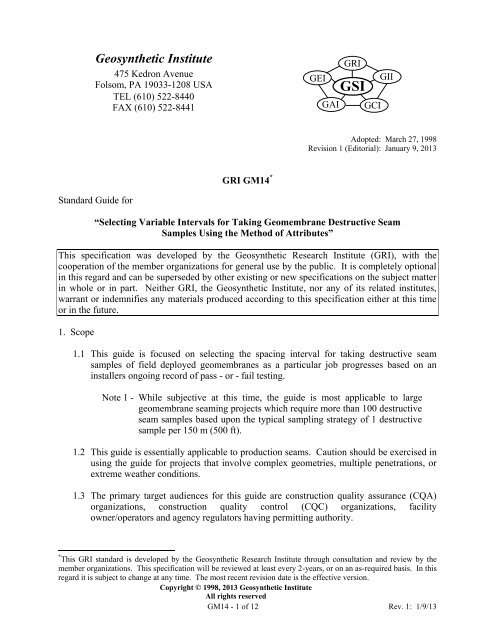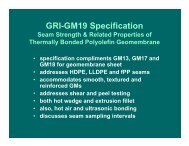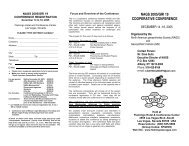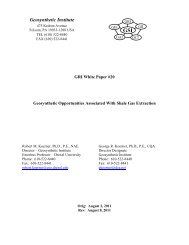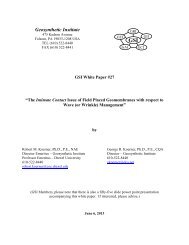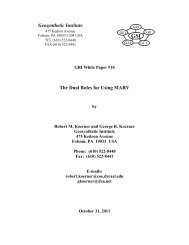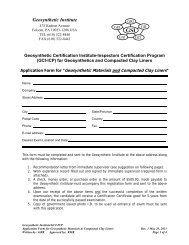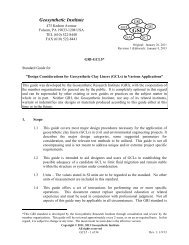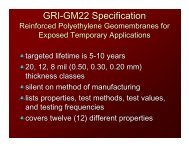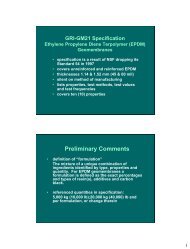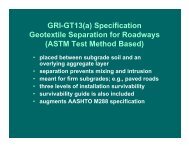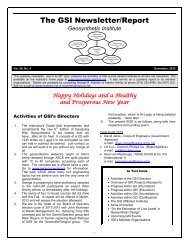GM14 - GM Sampling by Attributes - The Geosynthetic Institute
GM14 - GM Sampling by Attributes - The Geosynthetic Institute
GM14 - GM Sampling by Attributes - The Geosynthetic Institute
Create successful ePaper yourself
Turn your PDF publications into a flip-book with our unique Google optimized e-Paper software.
<strong>Geosynthetic</strong> <strong>Institute</strong>475 Kedron AvenueFolsom, PA 19033-1208 USATEL (610) 522-8440FAX (610) 522-8441GEIGRIGSIGAI GCIGIIAdopted: March 27, 1998Revision 1 (Editorial): January 9, 2013GRI <strong><strong>GM</strong>14</strong> *Standard Guide for“Selecting Variable Intervals for Taking Geomembrane Destructive SeamSamples Using the Method of <strong>Attributes</strong>”This specification was developed <strong>by</strong> the <strong>Geosynthetic</strong> Research <strong>Institute</strong> (GRI), with thecooperation of the member organizations for general use <strong>by</strong> the public. It is completely optionalin this regard and can be superseded <strong>by</strong> other existing or new specifications on the subject matterin whole or in part. Neither GRI, the <strong>Geosynthetic</strong> <strong>Institute</strong>, nor any of its related institutes,warrant or indemnifies any materials produced according to this specification either at this timeor in the future.1. Scope1.1 This guide is focused on selecting the spacing interval for taking destructive seamsamples of field deployed geomembranes as a particular job progresses based on aninstallers ongoing record of pass - or - fail testing.Note 1 - While subjective at this time, the guide is most applicable to largegeomembrane seaming projects which require more than 100 destructiveseam samples based upon the typical sampling strategy of 1 destructivesample per 150 m (500 ft).1.2 This guide is essentially applicable to production seams. Caution should be exercised inusing the guide for projects that involve complex geometries, multiple penetrations, orextreme weather conditions.1.3 <strong>The</strong> primary target audiences for this guide are construction quality assurance (CQA)organizations, construction quality control (CQC) organizations, facilityowner/operators and agency regulators having permitting authority.* This GRI standard is developed <strong>by</strong> the <strong>Geosynthetic</strong> Research <strong>Institute</strong> through consultation and review <strong>by</strong> themember organizations. This specification will be reviewed at least every 2-years, or on an as-required basis. In thisregard it is subject to change at any time. <strong>The</strong> most recent revision date is the effective version.Copyright © 1998, 2013 <strong>Geosynthetic</strong> <strong>Institute</strong>All rights reserved<strong><strong>GM</strong>14</strong> - 1 of 12 Rev. 1: 1/9/13
1.4 <strong>The</strong> outcome of using the guide rewards good seaming performance resulting from arecord of passing destructive seam tests. It also penalizes poor seaming performanceresulting from a record of excessively failing seam tests.1.5 This guide does not address the actual seam testing procedures that are used foracceptance or failure of the geomembrane seam test specimens themselves. Dependingon the type of geomembrane being deployed one should use ASTM D4437, D3083,D751 and D413 for testing details in this regard. <strong>The</strong> project-specific CQA plan shoulddefine the particular criteria used in acceptance or failure.1.6 An alternative to this method of attributes is that of using control charts for determiningthe variable interval for taking destructive seam samples. See GRI-<strong>GM</strong>20 in this regard.2. Referenced Documents2.1 ASTM Standards:D4437 Practice for Determining the Integrity of Field Seams Used in JoiningFlexible Polymeric Sheet GeomembranesD3083 Specification for Flexible Poly (Vinyl Chloride) Plastic Sheeting for Pond,Canal, and Reservoir LiningD751 Method of Testing Coated FabricsD413 Test Methods for Rubber Property - Adhesion to Flexible Substrate2.2 Other StandardsANSI/ASQC Z1.4 [1993]<strong>Sampling</strong> Procedures and Tables for Inspection <strong>by</strong> <strong>Attributes</strong>2.3 GRI Standards<strong>GM</strong>20 Selecting Variable Intervals for Taking Geomembrane Destructive SeamSamples Using Control Charts3. Summary of Guide3.1 Use of this guide requires the establishment of an anticipated geomembrane seamfailure percentage (ranging from 1 to 8%) and an initial, or start-up, sampling interval.Note 2 - <strong>The</strong> value of anticipated failure percentage is an importantconsideration. It dictates each decision as to a possible increase ordecrease in interval spacing from the preceding value. <strong>The</strong> percentageitself comes from historical data of the construction quality assurance(CQA) organization or regulatory agency. It is related to a number offactors including criticality of installation, type of geomembrane, type ofseaming method and local ambient conditions.<strong>The</strong> actual value is admittedly subjective and should be made known inadvance to the geomembrane installer before bidding the project. Use ofan unrealistically low value of anticipated failure percentage, e.g.,
intervals are concerned. Conversely, use of an unrealistically high valueof anticipated failure percentage, e.g., > 8.0%, will likely result in verylarge sampling intervals and quite possibly sacrifice the overall qualityof the seaming effort.3.2 <strong>The</strong> guide then gives the procedure for establishing the initial number of samplesneeded for a possible modification to the start-up sampling interval. This is called theinitial batch. Based upon the number of failed samples in the initial batch, the spacingis either increased (for good seaming), kept the same, or decreased (for poor seaming).3.3 A second batch size is then determined and the process is continued. Depending on theproject size, i.e., the total length of seaming, a number of decision cycles can occuruntil the project is finished.3.4 It is seen that the number of samples required for the entire project is either fewer thanthe start-up frequency (for good seaming); the same as the start-up frequency (formatching the initial anticipated failure percentage); or more than the start-up frequency(for poor seaming).4. Significance and Use4.1 Construction quality assurance (CQA) and construction quality control (CQC)organizations, as well as owner/operators and agency regulators can use this guide tovary the sampling interval of geomembrane seam samples (i.e., the taking of fieldsamples for destructive shear and peel testing) from an initial, or start-up, interval. Thisinitial interval is often one destructive seam sample in every 150 m (500 ft) of seamlength.4.2 <strong>The</strong> guide leads to increasing the sampling interval for good seaming practice (hencefewer destructive samples) and to decreasing the sampling interval for poor seamingpractice (hence additional destructive samples).4.3 Use of the guide should provide an incentive for geomembrane installers to upgrade thequality and performance of their field seaming activities. In so doing, the cutting offewer destructive samples will lead to overall better quality of the entire liner project,since the patching of previously taken destructive samples is invariably of poorerquality than the original seam itself.Note 3 - It is generally accepted that field patching of areas where destructivesamples had been taken using extrusion fillet seaming is less desirablethan the original seam which was made <strong>by</strong> hot wedge welding.4.4 Control charts are described in GRI-<strong>GM</strong>20 which can also be used <strong>by</strong> geomembraneinstallers and their construction quality control (CQC) personnel for improvement inoverall job quality and identification of poorly performing seaming personnel and/orequipment.<strong><strong>GM</strong>14</strong> - 3 of 12 Rev. 1: 1/9/13
5. Suggested MethodologyUsing the concepts embodied in the method of attributes, the following procedure is based onadjustments to sequential sampling.5.1 Typical Field Situation - In order to begin the process, a project-specific total seamlength must be obtained from the installers panel (roll) layout plan. Also, an initial, orstart-up, sampling interval must be decided upon. From this information the totalnumber of samples that are required based on the start-up sampling interval can beobtained.Example 1 - A given project has 54,000 m (180,000 ft) of field seaming.<strong>The</strong> start-up sampling frequency is 1 sample per 150 m (500 ft).<strong>The</strong>refore, the total number of samples required if the start-up interval iskept constant will be:54,000 360 samples1505.2 Determination of Initial Batch Size - Using the table shown below, the initial batch sizefrom which to possibly modify the start-up sampling interval is obtained.Table 1 - Batch Size Determination, after ANSI/ASQC Z1.4 [1993]No. of Required SamplesBased on Initial or Modified<strong>Sampling</strong> IntervalNo. of Samples Needed(Batch Size) to DetermineSubsequent <strong>Sampling</strong> Interval2 - 8 29 - 15 316 - 25 526 - 50 851 - 90 1391 - 150 20151 - 280 32281 - 500 50501 - 1200 801201 - 3200 125Example 1 (cont.) - For 360 samples, a batch size of 50 is necessary. Asproduction seaming progresses, these 50 samples are tested (either as theyare taken or in a batch) and the number of failures is determined.5.3 Verification of Start-Up <strong>Sampling</strong> Interval - A sampling table is now used whichseparates the number of failures within this initial batch size into three categories: arelatively low number of failures (where the sampling interval can be increased), theanticipated number of failures (where the sampling interval is maintained), or a<strong><strong>GM</strong>14</strong> - 4 of 12 Rev. 1: 1/9/13
elatively high number of failures (where the sampling interval should be decreased).Table 2 provides this information which is based upon the operation characteristic (OC)curves of Appendix B.Example 1 (cont.) - Assuming an anticipated failure percentage of 2%(recall Note - 2), Table 2 results in the three categories shown below:• 0 or 1 failure out of 50; the sampling interval can be increased• 2 or 3 failures out of 50; the sampling frequency should remain at 1sample per 150 m (500 ft)• 4 or more failures out of 50; the sampling interval should be decreasedTable 2 - <strong>Sampling</strong> Table Containing the Number of Failed Samples to be used for Interval<strong>Sampling</strong> Interval Modification, see Appendix A for detailsNo. of Required Samples No. of Samples Needed Anticipated Failure Percentage*Based on Initial or Modified (Batch Size) to Determine 1% 2% 3% 4%<strong>Sampling</strong> Interval Subsequent <strong>Sampling</strong> Interval I D I D I D I D2 - 8 2 0 1 0 1 0 1 0 19 - 15 3 0 1 0 1 0 2 0 216 - 25 5 0 1 0 1 0 2 0 226 - 50 8 0 1 0 1 0 2 0 251 - 90 13 0 1 0 2 0 2 0 391 - 150 20 0 2 0 3 1 3 1 4151 - 280 32 0 2 1 3 1 4 2 5281 - 500 50 0 3 1 4 2 5 3 6501 - 1200 80 1 4 2 6 3 7 5 91201 - 3200 125 2 5 4 7 5 9 7 11No. of Required Samples No. of Samples Needed Anticipated Failure Percentage*Based on Initial or Modified (Batch Size) to Determine 5% 6% 7% 8%<strong>Sampling</strong> Interval Subsequent <strong>Sampling</strong> Interval I D I D I D I D2 - 8 2 0 1 0 2 0 2 0 29 - 15 3 0 2 0 2 0 2 0 216 - 25 5 0 2 0 2 0 3 0 326 - 50 8 0 3 0 3 1 3 1 451 - 90 13 1 4 1 4 1 4 1 591 - 150 20 1 5 2 5 2 5 2 6151 - 280 32 2 6 3 6 3 7 4 7281 - 500 50 4 7 4 8 5 9 6 10501 - 1200 80 6 10 7 11 8 12 9 141201 - 3200 125 9 13 10 15 12 17 13 19No: *To be selected <strong>by</strong> CQA, owner or regulatory organizationsI = Increase the sampling interval if the number of failed samples found in the batch does not exceed thetabulated value.D = Decrease the sampling interval if the number of failed samples found in the batch equals or exceeds thetabulated value.5.4 Modification of Start-Up <strong>Sampling</strong> Interval - Depending upon the outcome of theprevious section, the start-up sampling interval may be modified to a new value whichwill then require a new batch size to verify the modification. <strong>The</strong> process is then<strong><strong>GM</strong>14</strong> - 5 of 12 Rev. 1: 1/9/13
continued until the project is finished. Two examples will be provided using the abovesampling table both with anticipated failure percentages of 2.0%: Example 2 illustratesgood seaming, and Example 3 illustrates poor seaming.Example 2 - Using the same project seam length and start-up samplingfrequency as in the previous example assume that the start-up batch of 50samples in the previous example had 2-failures. <strong>The</strong> decision is then tocontinue at a 1 destructive sample in 150 m (500 ft) sampling interval.Thus the second batch size from Table 1 is again 50 samples, see Table 3.Table 3(a) is in S.I. units and Table 3(b) is in English units. Now assumein the second batch there are no failures. This allows the samplinginterval to be increased, e.g., to 1 sample in 180 m (600 ft). From Table 1,the third batch size is then decreased to 32 samples. <strong>The</strong> process iscontinued in this manner until the project is concluded. For thishypothetical situation Table 3(a) illustrates that 265 samples (or 266samples when using the English units in Table 3(b)) are necessary. Notethat <strong>by</strong> using a constant interval of 1 sample in 150 m (500 ft), 360samples would have been necessary. Also note that the maximumsampling interval was fixed at 310 m (1000 ft).Note 4 - This example, and the following one, use a changing sampling interval of ±20% from the previous value. That is, when good seaming allows for anincrease in sampling interval; the progression being from 150, 180, 215, 260to 310 m (500, 600, 720, 850 to 1000 ft), respectively. A maximum intervalof 310 m (1000 ft) is recommended, but clearly this value is at the discretionof the organizations involved. Conversely, poor seaming requires adecrease in sampling interval; the progression being from 150, 120, 100, 80to 65 m (500, 400, 320, 250 to 200 ft), respectively. A minimum interval of65 m (200 ft) is recommended, but clearly this decision is also at thediscretion of the organizations involved<strong><strong>GM</strong>14</strong> - 6 of 12 Rev. 1: 1/9/13
Table 3(a) - Results of Example 2 (in S.I. Units) Illustrating the Variation of the <strong>Sampling</strong>Interval Based on a 2.0% Anticipated Failure Percentage With a "Good" Quality InstallerBatch <strong>Sampling</strong> Interval No. of Remaining Batch Cumulative Distance Number of Decisionnumber (m) Samples Required size (m) failures made1 150 360 50 7500 2 Stay2 150 310 50 15000 0 Increase3 180 217 32 20760 0 Increase4 215 155 32 27640 2 Stay5 215 123 20 31940 1 Stay6 215 103 20 36240 0 Increase7 260 68 13 39620 1 Stay8 260 55 13 43000 0 Increase9 310 35 8 45480 0 Stay10 310 27 8 47960 0 Stay11 310 19 5 49510 0 Stay12 310 14 3 50440 0 Stay13 310 11 3 51370 0 Stay14 310 8 2 51990 0 Stay15 310 6 2 52610 0 Stay16 310 4 2 53230 0 Stay17 310 2 2 53850 0 DoneTotal Number of tests per 54,000 m of seam project = 265Table 3(b) - Results of Example 2 (in English Units) Illustrating the Variation of the <strong>Sampling</strong>Interval Based on a 2.0% Anticipated Failure Percentage With a "Good" Quality InstallerBatch <strong>Sampling</strong> Interval No. of Remaining Batch Cumulative Distance Number of Decisionnumber (m) Samples Required size (m) failures made1 500 360 50 25000 2 Stay2 500 310 50 50000 0 Increase3 600 217 32 69200 0 Increase4 720 154 32 92240 2 Stay5 720 122 20 106640 1 Stay6 720 102 20 121040 0 Increase7 850 69 13 132090 1 Stay8 850 56 13 143140 0 Increase9 1000 37 8 151140 0 Stay10 1000 29 8 159140 0 Stay11 1000 21 5 164140 0 Stay12 1000 16 5 169140 0 Stay13 1000 11 3 172140 0 Stay14 1000 8 2 174140 0 Stay15 1000 6 2 176140 0 Stay16 1000 4 2 178140 0 Stay17 1000 2 1 179140 0 DoneTotal Number of tests per 180,000 ft of seam project = 266<strong><strong>GM</strong>14</strong> - 7 of 12 Rev. 1: 1/9/13
Example 3 - Using the same project seam length and start-up samplingfrequency as Example 1, assume that the start-up batch of 50 samples had3- failures. <strong>The</strong> decision is then to continue at a 1 destructive sample in150 m (500 ft) sampling interval. Thus the second batch size is again 50samples as it was with Example 2, see Table 4. Table 4(a) is in S.I. unitsand Table 4(b) is in English units. Now assume in the second batch thereare 2-failures. <strong>The</strong> decision is to again continue at a 1 destructive samplein 150 m (500 ft) sampling interval. From Table 1, the third batch size isthen decreased to 32 samples. <strong>The</strong> process is continued in this manneruntil the project is concluded. For this hypothetical situation Table 4illustrates that 412 samples are necessary. Note that <strong>by</strong> a constant intervalof 1 sample in 150 m (500 ft), 360 samples would have been necessary.Furthermore, a good seamer (as illustrated in Example 2) would only havehad to take 265 samples.Table 4(a) - Results of Example 3 (in S.I. Units) Illustrating the Variation of the <strong>Sampling</strong>Interval Based on a 2.0% Anticipated Failure Percentage With a "Poor" Quality InstallerBatch <strong>Sampling</strong> Interval No. of Remaining Batch Cumulative Distance Number of Decisionnumber (m) Samples Required size (m) failures made1 150 360 50 7500 3 Stay2 150 310 50 15000 2 Stay3 150 260 32 19800 2 Stay4 150 228 32 24600 3 Decrease5 120 245 32 28440 3 Decrease6 100 256 32 31640 1 Increase7 120 186 32 35480 1 Increase8 150 123 20 38480 2 Stay9 150 103 20 41480 1 Stay10 150 83 13 43430 2 Decrease11 120 88 13 44990 2 Decrease12 100 90 13 46290 1 Stay13 100 77 13 47590 1 Stay14 100 64 13 48890 1 Stay15 100 51 13 50190 0 Increase16 120 32 8 51150 1 Stay17 120 24 5 51750 1 Decrease18 100 23 5 52250 0 Increase19 120 15 3 52610 0 Increase20 150 9 2 52910 1 Decrease21 120 9 2 53150 1 Decrease22 100 11 3 53210 0 Increase23 120 7 2 53390 0 Increase24 150 5 2 53510 0 Increase25 180 3 2 53750 0 DoneTotal Number of tests per 54,000 m of seam project = 412<strong><strong>GM</strong>14</strong> - 8 of 12 Rev. 1: 1/9/13
Table 4(b) - Results of Example 3 (in English Units) Illustrating the Variation of the <strong>Sampling</strong>Interval Based on a 2.0% Anticipated Failure Percentage With a "Poor" Quality InstallerBatch <strong>Sampling</strong> Interval No. of Remaining Batch Cumulative Distance Number of Decisionnumber (m) Samples Required size (m) failures made1 500 360 50 25000 3 Stay2 500 310 50 50000 2 Stay3 500 260 32 66000 2 Stay4 500 228 32 82000 3 Decrease5 400 245 32 94800 3 Decrease6 320 266 32 105040 1 Increase7 400 187 32 117840 1 Increase8 500 124 20 127840 2 Stay9 500 104 20 137840 1 Stay10 500 84 13 144340 2 Decrease11 400 89 13 149540 2 Decrease12 320 95 13 153700 1 Stay13 320 82 13 157860 1 Stay14 320 69 13 162020 1 Stay15 320 56 13 166180 0 Increase16 400 35 8 169380 1 Stay17 400 27 5 171380 1 Decrease18 320 27 5 172980 0 Increase19 400 18 3 174180 0 Increase20 500 12 2 175180 1 Decrease21 400 12 2 175980 1 Decrease22 320 13 3 176140 0 Increase23 400 10 2 176780 0 Increase24 500 6 2 177140 0 Increase25 600 5 2 177980 0 DoneTotal Number of tests per 54,000 m of seam project = 4125.5 SummaryThis guide illustrates <strong>by</strong> means of hypothetical examples how a CQA and/or CQCorganization can modify the sampling interval for taking destructive samples from ageomembrane seaming project. It is based on the method of attributes which iscommon to statistical control methods. <strong>The</strong> methodology uses sequential sampling toproceed from one decision to the next until the project is complete.<strong>The</strong> result in using this guide for the above purpose is to reward good seamingperformance <strong>by</strong> taking fewer destructive samples, and to penalize poor seamingperformance <strong>by</strong> taking additional destructive samples. In the example illustrations,good seaming resulted in taking 265 samples (versus 360), or a decrease of 26% fromthe originally set constant interval of 1 sample per 150 m (500 ft). Conversely, poorseaming resulted in taking 412 samples (versus 360), or a 14% increase in theoriginally set constant interval of 1 sample per 150 m (500 ft.) of seam length.<strong><strong>GM</strong>14</strong> - 9 of 12 Rev. 1: 1/9/13
<strong>GM</strong> 14 - Appendix A - <strong>The</strong> Selection of the "I" and "D" ValuesIn this appendix, the procedure used for selecting the "I" and "D" values listed in Table 2 ispresented. <strong>The</strong> required background, e.g., the concept of sampling risk and the operatingcharacteristics (OC) curves, are briefly discussed.<strong>Sampling</strong> Risk<strong>Sampling</strong> involves a degree of risk that the actual samples do not adequately reflect theconditions of the lot. For example, when using the sampling plan recommended in this guide,there are two common risks [see Juran and Gryna (1980) and Juran el. al (1974) for details]:1. A good seaming practice might be penalized. This is generally referred as the installer’srisk and denoted as the risk.2. A poor seaming practice might go undetected. This is generally referred as anowner/regulators risk and denoted as the risk.<strong>The</strong> effects (impacts) of the relative degree of these two risks are summarized in Table B1.RelativeTable B1 - <strong>The</strong> Effects of the Relative Degree of and Risks.Types of RisksDegree Installers () Risk Owner/Regulators () RiskLowHighLoose CQA control; low testingcostTight CQA control; high testingcostTight CQA control; high testing costLoose CQA control; low testing costOperating Characteristics (OC) CurvesBoth of the risks can be quantified <strong>by</strong> sampling-plan-specific operating characteristics (OC)curves. <strong>The</strong> OC curve for a sampling plan is a graph which plots the probability that thesampling plan will accept a lot (i.e., the Pa value) versus the percent defective samples in thatparticular lot. Note that the term "sampling plan" used here corresponds to a batch of "n"destructive testing samples and the criteria for adjusting the sampling interval. Recall Table 2 inthe main body of this guide. Figure B1 illustrates the concept of OC curves. In Figure B1, thedashed curve represents an "ideal" OC curve. Here it is desired to accept all lots having less orequal than 2% and reject all lots having greater than 2% failures. In reality, all sampling planshave risks that a "good" lot will be rejected or a "bad" lot will be accepted. This is illustrated <strong>by</strong>the solid S-shaped curve shown in Figure B1. It is seen that this particular sampling plan willhave a 5% risk (100% - 95%) of rejecting a lot having only 1% defects (i.e., a "good" lot) and a10% risk of accepting a lot having 5% defects (i.e., a "bad" lot).<strong><strong>GM</strong>14</strong> - 10 of 12 Rev. 1: 1/9/13
Figure B1 - Ideal and Actual Operating Characteristics Curves for a <strong>Sampling</strong> PlanAn OC curve can be developed <strong>by</strong> determining the probability of acceptance for several valuesof the percent defects. To do so, a statistical distribution of the acceptance probability has to beassumed first. <strong>The</strong>re are three distributions which can be used: hypergeometric, binomial andPoisson distribution. <strong>The</strong> Poisson distribution is generally preferable due to the ease ofcalculation. It is used in this guide. <strong>The</strong> Poisson distribution function to be applied to anacceptance sampling plan is as follows:exactly" c"defects eP ina batch of size " n"np( np)c!Most statistics books provide Poisson distribution tables which give the probability of "c" or lessdefects in a batch of size "n" from a lot having a fraction of defect "p".c(B1)<strong>The</strong> Selection of the "I" and "D" Values Listed in Table 2As mentioned earlier, each of the sampling plans recommended in this guide consists of threevariables: the batch size "n", the values of "I" and "D". Note that the values of "I" and "D" arespecific values of "c" mentioned in Equation B1. <strong>The</strong> "I" value corresponds to the judgmentcriterion of rewarding good seaming practice, i.e., increasing the sampling interval if the numberof failed samples does not exceed this particular value. <strong>The</strong> "D" value, on the other hand,corresponds to the judgment criterion of penalizing poor seaming practice, i.e., decreasing thesampling interval if the number of failed samples equals or exceeds this particular value.<strong>The</strong> concept of the OC curves is used to determine the actual values of I’s and D’s for differentsampling plans. <strong>The</strong> criteria used are as follows:For a batch of size "n", the "I" value should yield a 80~90% probability of rewardinggood seaming practice, i.e., 80% < Pa < 90%.<strong><strong>GM</strong>14</strong> - 11 of 12 Rev. 1: 1/9/13
For a batch of size "n", the "D" value should yield a risk of 0.5% or less of penalizinggood seaming practice, i.e., Pa >99.5%. In other words, the probability for good seamingpractice to be penalized is extremely small, i.e., less than 0.5%.<strong>The</strong> above criteria is subjective. Nevertheless, it is felt to be adequate since the rights of both theinstaller and the owner/regulator are protected. Recognize that a sampling plan with tightercontrol (i.e., smaller values of "I" and "D") might seem to be more ideal at first glance, but itmay result in a significant increase in the required number of destructive tests, i.e., it may becounter productive.As an illustration, Figure B2 shows the graphic procedure of obtaining the "I" and "D" values fora batch of 50 samples (n=50) and an anticipated failure percentage of 4%. [In other words, itillustrates the procedure of obtaining one particular pair of numbers listed in Table 2, namely, "I"and "D" equal to 3 and 6, respectively.] Note that each OC curve shown in Figure B2corresponds to a specific "c" value and is obtained via a Poisson distribution table.Figure B2 can also used to determine the values of "I" and "D" for sampling plans with the samebatch size (i.e., n = 50) but different anticipated failure percentage. <strong>The</strong> rest of the values listedin Table 2 can be verified in a similar manner using OC curves corresponding to different batchsizes.Figure B2 - <strong>The</strong> Determination of the Values of "I" and "D" for a Batch with 50 Samples and anAnticipated Failure Percentage of 4.0%.<strong><strong>GM</strong>14</strong> - 12 of 12 Rev. 1: 1/9/13


